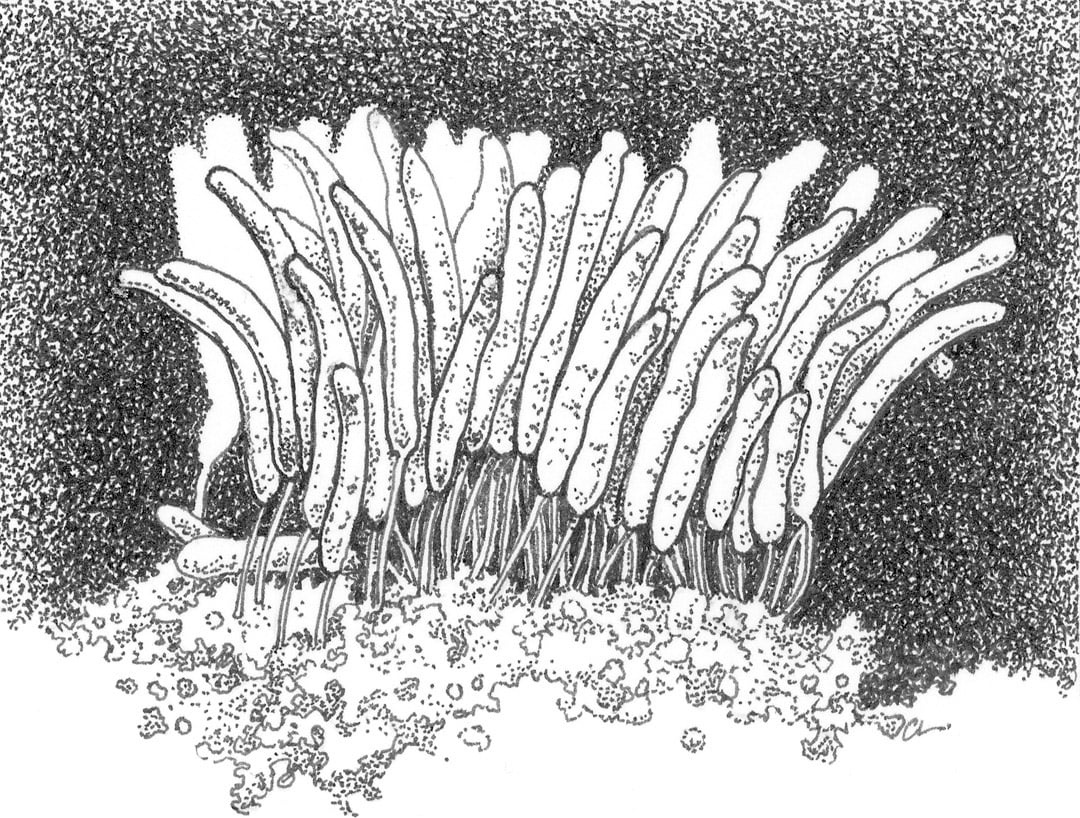

Contributor
- Topics: Archive

Soil Microbes: Life Beneath Our Feet
The air into which plants extend their stems, leaves, flowers, and fruits is a virtual desert compared to the soil in which their roots seek anchorage, water, and nourishment. Just about every available surface under our feet is covered with life; even the thin film of water that coats soil particles and lines pores in the soil harbors microscopic organisms that swim in those minute spaces. Without living organisms, soil would be merely crushed rock. It is the interactions between microorganisms and mineral components, fueled by sunlight and chemical reactions, that break down rock and gradually convert it into soil. The number of organisms found in soil boggles the imagination: a mere gram may contain a billion bacteria and 200 meters of fungal hyphae!
Decomposition
Charles Darwin, well known for his theory of evolution by natural selection, is also recognized as the founder of soil ecology; but it was Louis Pasteur who first demonstrated that organic material was decomposed by bacteria, not as a result of chemical reaction. Bacteria are an essential part of the soil food web, breaking down organic matter, converting inorganic matter into organic forms, and serving as food for other organisms. All the kingdoms of life are involved in the decomposition of organic matter, which makes nutrients available to plants (and ultimately animals), but only bacteria are able to make all the essential elements available. In addition to bacteria, slime molds, protozoans, lichens, a variety of fungi, and other, more obscure organisms, have important roles in decomposing organic matter and building soil.
Building Soil
Begin with bare rock—the Hawaiian Islands, for instance. The first organisms to colonize land newly created by lava flows must be able to provide their own nutrients by means of light or chemical energy. Cyanobacteria (blue-green algae), the first colonizers, are able to photosynthesize; some are able to “fix” atmospheric nitrogen, making it available to plants. Lichens (an alliance between fungi and algae) are also early colonizers, providing their own nutrients; they also produce unusual acids that help break down rock. Eventually, as a thin layer of soil develops on the lava, higher plants begin to move in; many of the first have a nitrogen-fixing capability. As a more complex flora develops, organic materials are broken down and contribute to soil formation. Organic matter improves water-holding capacity, buffers pH, and provides nutrients. Humus represents organic matter that is resistant to continued decomposition; it becomes highly stable, and functions in many soil chemical reactions. Humus contributes to soil a crumbly, spongy texture, and a rich, dark color (resembling seventy percent dark chocolate).
Soil Food Web
The soil food web is now recognized to influence biodiversity and interactions above the soil surface, and scientists are increasingly paying attention to what is happening beneath our feet. The organisms that facilitate the process of breaking down organic materials are called decomposers, scavengers, detritivores, saprophages, or recyclers. Whatever we call them, a succession of these abundant organisms breaks down organic materials, and contributes to soil fertility. Larger organisms, such as worms, move the soil around, creating pores and aggregates of soil particles. In turn, a wide variety of predators, parasites, and pathogens regulate the populations of soil organisms. The same organisms that break down organic material are building soil. The axiom “feed your soil,” it turns out, is truly the crux of successful gardening, and the “black gold” produced by the backyard compost pile is a gardener’s treasure house.

Strange Organisms
In addition to the roles of predator, parasite, and herbivore, examples of soil food web roles include fungivores (feed on fungi), coprophages (feed on dung), and the bacterial and fungal partners (such as mycorrhizae) that assist in nutrient and water uptake by plant roots (to be explored in a future article). Many strange and wonderful organisms, visible only with a microscope, inhabit the soil. Archaea were once thought to occur only in extreme environments such as hot springs and saline soils, but have now been found in association with roots in more ordinary environments. Eubacteria (true bacteria) are found principally around plant roots, where they find a nutrient source in root exudates and dead cells. Actinomycetes contribute the wonderful “earthy” smell of freshly turned soil, and are a source of antibiotics such as streptomycin, tetracycline, and actinomycin. In the soil food web, antibiotics regulate bacteria. The sugar fungi (in the fungal phylum Zygomycota) include the first fungi to attack dead leaves. Slime molds help to break down leaves and wood by engulfing food in their path. Protozoans patrol the film of water in soil pores, also regulating the bacterial community. Other organisms, such as oomycetes (water molds), chytrids, and hypochytrids, are members of the soil food web.
“We know more about the movement of celestial bodies than about the soil underfoot,” Leonardo da Vinci told us long ago, and it is still true today. As we turn our attention to the soils in which our gardens grow, we are discovering a new world to explore and a re-affirmation of the wonders of life that surround us every time we step out our door.

In a Nutshell
Popular Names:
Bacteria, protozoans, blue-green algae (cyanobacteria), green, red, and yellow algae, diatoms, slime molds, actinomycetes, fungi, lichens, water molds, chytrids, oomycetes.
Common Groups:
Protista groups several phyla that may not be closely related; these are single-celled or multicellular organisms with no specialization of tissues, and include protozoans, slime molds, and other groups of eukaryotic (cells with a membrane-bound nucleus) microorganisms. Archaebacteria includes extremophiles and some root-associated organisms. Fungi include several distinct phyla: sugar fungi are in phylum Zygomycota; yeasts, and a few mushrooms, such as the well-known morels and cup fungi, are in phylum Ascomycota; most familiar mushrooms, including all those with gills, are in phylum Basidiomycota. Lichens are a mutualistic relationship between fungi and algae. Algae may be included with the Eubacteria (blue-green algae), Stramenophila (yellow and brown algae and diatoms), or Plantae (green and red algae).
Distribution:
Worldwide. Most species of soil microbes remain undescribed. Some groups, such as slime molds, include only a few hundred species; bacteria may include millions of species.
Life Cycle:
Most of the single-celled organisms reproduce by simple fission, splitting into two. Fungi have complex reproductive strategies. Algae have various reproductive strategies.
Appearance:
Varied and diverse; the majority are visible only through a microscope.
Life Span:
Varied. Soil bacteria and protozoans are short-lived, but lichens and some fungi may live many years.
Diet:
Autotrophs (plants, algae, and some bacteria and protozoans) provide their own nourishment and can produce complex organic molecules using light energy or by chemical reactions. Heterotrophs (all other living organisms) rely on autotrophs to produce the organic molecules necessary to support life.
Benefits:
Humus in the soil helps it hold water and nutrients, creates a spongy structure, and provides a hospitable home for plants and soil organisms.
Problems:
Some bacteria, fungi, and other organisms cause plant diseases; oomycetes, for example, cause sudden oak death and potato blight.
Interesting facts:
Some bacteria can break down pesticides and other pollutants. Archaea (also known as extremophiles) are usually found in places like hot springs, anaerobic environments, deepsea thermal vents, and salty soils; some have been discovered to have associations with plant roots.
Sources:
It is relatively simple to enhance the microbiology of garden soils with the addition of compost and organic materials. Seriously depleted soils may benefit from the addition of commercial inoculants to boost microbial activity.
More information:
Life in the Soil: A Guide for Naturalists and Gardeners, JM Nardi. [click here to read a review of this book]
Teaming with Microbes: A Gardeners Guide to the Soil Food Web, Joel Lowenfels & Wayne Lewis (Timber Press, 2006).
https://www.sonoma.edu/preserves/education/edmaterials.shtml. A soil-building terrarium-a fun project that inexpensively and actively demonstrates the process of soil-building.
https://assets.cambridge.org/97805216/21113/excerpt/9780521621113_excerpt.pdf. Provides an in-depth explanation of nutrient cycling.










Responses